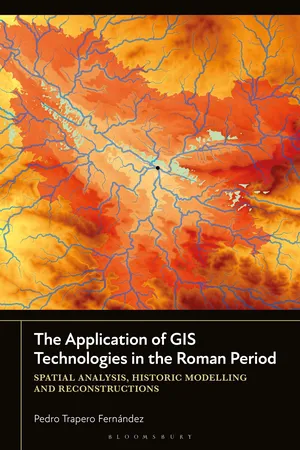
eBook - ePub
The Application of GIS Technologies in the Roman Period
Spatial Analysis, Historic Modelling and Reconstructions
- 232 pages
- English
- ePUB (mobile friendly)
- Available on iOS & Android
eBook - ePub
The Application of GIS Technologies in the Roman Period
Spatial Analysis, Historic Modelling and Reconstructions
About this book
Using a selection of archaeological cases studies from the Roman period in the Mediterranean region, Pedro Trapero Fernández shows how GIS technologies can be employed in the creation of spatial models to reproduce historical realities. An increasing number of researchers use this digital humanities tool as a means to model both territory and landscape. This book compiles different spatial models under a unified methodology described in separated chapters, such as mobility and visibility models, and discusses their limitations and potential for implementation in archaeological contexts. The result is a detailed analysis of each method, which consequently results in an accessible manual for understanding GIS technologies.
Designed for students and scholars with varying degrees of training in GIS, who intend to carry out spatial analysis and historical models, the approach of this book establishes a reference framework to work with GIS technologies in other historical periods. Trapero concludes by discussing the future of GIS and spatial analysis, and how it can be studied and used as a methodological approach in archaeological practice and research.
Designed for students and scholars with varying degrees of training in GIS, who intend to carry out spatial analysis and historical models, the approach of this book establishes a reference framework to work with GIS technologies in other historical periods. Trapero concludes by discussing the future of GIS and spatial analysis, and how it can be studied and used as a methodological approach in archaeological practice and research.
Frequently asked questions
Yes, you can cancel anytime from the Subscription tab in your account settings on the Perlego website. Your subscription will stay active until the end of your current billing period. Learn how to cancel your subscription.
At the moment all of our mobile-responsive ePub books are available to download via the app. Most of our PDFs are also available to download and we're working on making the final remaining ones downloadable now. Learn more here.
Perlego offers two plans: Essential and Complete
- Essential is ideal for learners and professionals who enjoy exploring a wide range of subjects. Access the Essential Library with 800,000+ trusted titles and best-sellers across business, personal growth, and the humanities. Includes unlimited reading time and Standard Read Aloud voice.
- Complete: Perfect for advanced learners and researchers needing full, unrestricted access. Unlock 1.4M+ books across hundreds of subjects, including academic and specialized titles. The Complete Plan also includes advanced features like Premium Read Aloud and Research Assistant.
We are an online textbook subscription service, where you can get access to an entire online library for less than the price of a single book per month. With over 1 million books across 1000+ topics, we’ve got you covered! Learn more here.
Look out for the read-aloud symbol on your next book to see if you can listen to it. The read-aloud tool reads text aloud for you, highlighting the text as it is being read. You can pause it, speed it up and slow it down. Learn more here.
Yes! You can use the Perlego app on both iOS or Android devices to read anytime, anywhere — even offline. Perfect for commutes or when you’re on the go.
Please note we cannot support devices running on iOS 13 and Android 7 or earlier. Learn more about using the app.
Please note we cannot support devices running on iOS 13 and Android 7 or earlier. Learn more about using the app.
Yes, you can access The Application of GIS Technologies in the Roman Period by Pedro Trapero Fernández in PDF and/or ePUB format, as well as other popular books in Social Sciences & Digital Media. We have over one million books available in our catalogue for you to explore.
Information
Table of contents
- Cover
- Half-Title Page
- Series Page
- Title Page
- Contents
- List of Illustrations
- List of Tables
- 1 Introduction
- 2 GIS Applied to History and Archaeology
- 3 GIS Software and Tips
- 4 Resources and Methodology
- 5 Land Use Models
- 6 Restitution of Historical Landscapes
- 7 Mobility Models
- 8 Visibility Models
- 9 Boundaries and Prediction Models
- 10 Perspectives and Future Lines of Action
- Bibliography
- Index
- Copyright